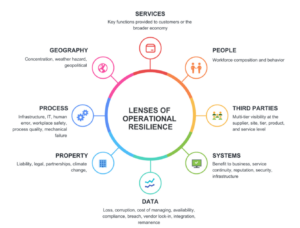As businesses are preparing to reopen, they are realizing it is not as simple as turning the demobilization model around and following the footsteps in reverse order. In order to return to better than business as usual, you will need to change how you operate. If you don’t change, the new normal will be painful and may eventually fail. You can avoid the pain and failure by leveraging innovative technology. Here’s how to take advantage of innovation to survive and thrive.
 First, a few baseline points:
First, a few baseline points:
To meet any degree of operational resilience, one must first recognize that the business is woven together like a fabric. All the threads fit tightly together to accomplish one cohesive purpose. We need to consider all the threads that enable the organization to fulfill its’ purpose.
When we think in silos, we act in silos. To achieve success in managing any disruptive event, it is imperative that we think collectively and act collaboratively.
The collaboration starts long before the event happens and certainly before it is time to restore the operation. Being prepared starts with being informed. How does your business work? How might it break? How can we protect it, prepare and respond?
To answer these questions, you need data. Data that on the surface appears to be disparate from many of the various threads. In reality, incomplete, inaccurate, and disconnected data results in chaos and confusion. Both in reacting/responding to the event and restoring business operations.
Business leaders need to redefine the concept and approach to resiliency.
- Breakdown the traditional silos that keep information segregated by department
- Create one data set that integrates with your existing risk management information system
- Gain powerful insights into operational performance and success metrics
This new viewpoint is the springboard to intelligence that enables informed business decisions to better manage the disruptive event and on a daily operational level.
Innovative technology will allow your organization to:
- Accurately Manage: Leverage the data you already have in hand to gather a real-time view of critical business services to create a single view of the entire organization.
- Increase Efficiency: Spend less on cost of compliance while doing more. Eliminate redundancy, streamline and simplify by understanding the dependencies and critical elements of business processes.
- React Faster: Respond to an always-changing risk landscape Understand current level of utilization, where teams are bogged down, processes that need more investment or where approaches can be consolidated. Get clarity on single points of failure and course-correct before it’s too late.
- Be Laser-focused: Elevate what is important when it is important, by understanding the real impact. Monitor signals in your operating environment to take a proactive approach in resolving issues before they become a crisis.
It is through innovative technology that business leaders will have the facts to help them address the myriad of questions and issues to be addressed in order to prepare and conduct a return to business operations. More importantly, technology can present a broad enough, single view to help them return to a better business.
In terms of reopening from the pandemic. Leaders should consider a 3-part approach:
- Can we return?
- Should we return?
- How do we return?
Can we return? In other words: Are we eligible to reopen?
The questions that need to be addressed include:
- What are the federal, state, and local (and maybe even international) requirements and guidelines based upon where my facilities are located?
- Do we meet the criteria to be allowed to reopen for each site? For phase-1, phase-2, phase-3?
- How do I keep tabs on the rapidly changing requirements and guidelines?
- Which facilities are eligible and ready to reopen?
- What requirements are unresolved in order to open?
- What’s the impact on business services/customers if certain sites can reopen but other cannot?
The proper technology will enable you to document the requirements. Collect your ability (in real-time) to comply with the requirements at each location and through each business service. Monitor your eligibility based on the compliance status and clearly see any gaps and assign the issues to the appropriate leader for resolution. Clearly recognize the business impacts of certain areas not in compliance.

Should we return? In other words: Are we capable of reopening?
The questions that need to be addressed include:
- What changes to our operating model should we make? Are we positioned to operate the new way? Are employees, vendors, and customers aware? Have we documented/updated and distributed new policies?
- What are my risks and liabilities for workers and customers at each location? How are we addressing those concerns?
- Am I compliant with federal, state, local, and corporate policies and guidance?
- How do we know if we’re ready? Do we have enough staff who can/want to come back? What are the obstacles? (e.g., safety, transportation, school – child/elder care, etc.)
- What’s the impact on business services/customers if certain sites can reopen but other cannot?
- What Facility EH&S remediation is required, necessary and status of each item?
- Is our full ecosystem ready to support end to end business services? (e.g., internal dependencies, supply/service chains, partners, customers). If not, what are the implications/impacts?
- Do we have a communication strategy?
- Do we have documented/communicated “back-out” plans?
The proper technology will enable business leaders to collect information (real-time) from all employees about their ability to return. Confirm your supply chain and service chain partners are able to meet your requirements to fulfil your ecosystem. Report current state of environmental and safety remediation required, necessary and the status of each item from each of your locations. Identify and monitor the risk and impacts to business services and manage resource capabilities.
How do we return? In other words: Are we fully ready to reopen?
The question that need to be addressed include:
- Documented decisions and company-wide action plans?
- Dealing with the third parties (e.g., suppliers, vendors, partners, customers) – are there any parties that are having challenges in supporting my operations? What are those challenges and their resolution status?
- Are we staffed enough? How do we stage personnel and how do we social distance? (e.g., shift work, remote work, essential/non-essential, etc.)
- How do we address when remote employees are still restricted?
- Is it necessary to enact the back-out plan and what are the implications?
- Implement communication strategy, internally and externally.
- How do we model frequency to monitor restoration activity, status, and results?
The proper technology will enable business leaders to push standard actions to plans from a centralized library, orchestrate the sequence of tasks across the enterprise, and easily collect information from internal and external stakeholders into a single system for appropriate decisions. This includes everyone’s readiness to return to supporting the business at an acceptable level and finally confirm the organization’s readiness to reopen through real-time reports and dashboards.
There is no doubt these are trying times for everyone. I encourage you to take a step back and recognize the following:
This is a moment of truth for firms – for their resilience, purpose, values and commitments – but also agility and creativity. We don’t know for sure what will happen in the future. But when it does come, we need to be ready for it in advance. There will be lasting shifts, new needs, and different priorities. Organizations that consider and address impacts across the short, mid, and long-term will turn a crisis into an opportunity. Companies need to be prepared, agile and decisive. Leveraging the right innovative technologies will enable firms to emerge a better business going forward.
Learn more about COVID-19 restoration and download the Post-COVID-19: Planning for a New Normal and After-Action Report Guidelines on the Resilience Toolkit.






